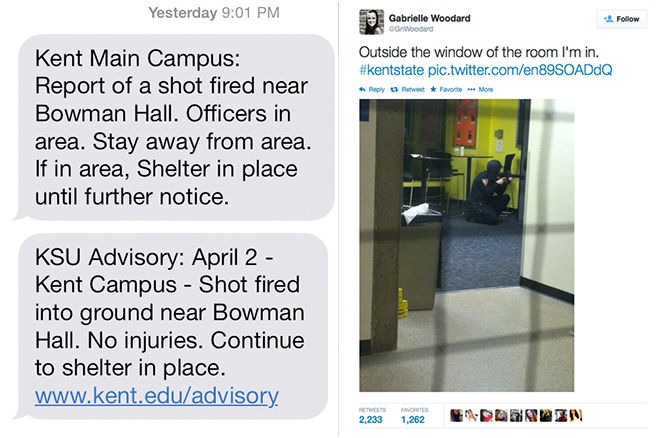Kent State searches to find relations between social media and crisis
Flash Alerts and an example of a student’s tweet from the event last April when a shot was fired on Kent State’s campus.
January 15, 2015
Three Kent State professors received a grant to study how people use social media during crises.
“When there is a crisis, for example an earthquake, hurricane or wildfire, what people want to do first is try to find as much information as they want,” said Xinyue Ye, Kent State assistant geography professor. “Official urgency will have public release, but it has to be verified, which normally the big picture changes so fast and when you wait for that information, it might be too late.”
Ye, geography professor Jay Lee and associate computer science professor Ruoming Jin were given $300,000 from the National Science Foundation to carry out their research. Kent State is working along with San Diego University and the University of Arkansas as part of a $999,887 grant.
Ye said he hopes their research will be able to help them better analyze who are the “opinion leaders” of the world, one case study in particular involved working with San Diego’s population due to the common cases of wildfires in California and how those people can help deliver important information to the public when crises occurs.
They have used various social network analysis tools to analyze the top 1000 Twitter users from the official County of San Diego Twitter account (@SanDiegoCounty), as well as other related news outlets.
These users have the potential to become volunteers for the Office of Emergency Services, Ye said.
“We want to make sure that the public can receive the most important alert messages from official agencies as quick as possible and that these critical messages will not be overwritten by other social media messages,” Ye said.
Their hope is for those top influential people to be able to be the first to retweet important announcements from Office of Emergency Services that need to be broadcasted. They will be given an automatic communication system to remind them.
At Kent State, Zhuo Chen, graduate geography student, is helping the lead researchers with the study to find if there is any pattern that social media’s message follows, also known as meme diffusion.
On Twitter, Chen said meme diffusion acts as retweets. Some contents of messages spread very fast and can last for a long period of time, but some “die” in a few seconds. By retweeting a message, which other people also retweet, the message spreads out.
“The situation is that a large amount of students are willing to share their opinion on social media, especially on important events going on in the world,” Chen said
Nick Bell, a junior computer information systems major, said the last time he received information regarding breaking news on his phone dealt with the attack at the Charlie Hebdo offices in Paris. At Kent State, he has recently received alerts regarding the Ebola scare through text messages and Facebook.
Bell said he gets phone alerts through CNN when major breaking news occurs, and he also reads about it on Twitter. He said he believes a positive of receiving breaking news on social media is that it’s faster, and people can automatically get an alert on their phones.
“I’d say (the study) is good as long as the person (chosen) is a credible person,” Bell said. “As long as it’s someone who is responsible or someone who’s viewed more for what they say than who they are, then it’ll be good.”
For Chen, he said he thinks the research will benefit society as a whole.
“For example, when a disaster like a tsunami happens, we can simulate how meme diffuse works and therefore predict the proceedings of meme diffusion and help people evacuate from the disaster effectively,” Chen said.
Recently, Ye said he also is working with faculty from the sociology and communication departments at Kent State to look at past events here on campus, including the power plant fire and the Ebola scare in Northeast Ohio, and analyze those tweets.
“We need to work with the community,” Ye said. “I would not say social media will solve everything, but it will become an important source to allow us to understand how people view it and weeks after if it’s forgotten or is it still talked about.”
Two other factors Ye said he hopes to find in his research are reaching out to health providers and caregivers for elderly people who don’t use social media often in order to introduce social media channels to senior communities and health centers, as well as finding a way to help relay important information to students who are foreign on campus.
“I’m working (with the sociology department) to see that when we talk about social media, we are talking about English-dominant social media,” Ye said. “How can the same things spread across different languages — how can Chinese, English, Spanish cross, especially now with more international students here on campus?”
Ye said research for this study included a four-year plan, which began in 2014. The NSF requires the researchers to report every year.
Contact Melissa Puppo at [email protected].












